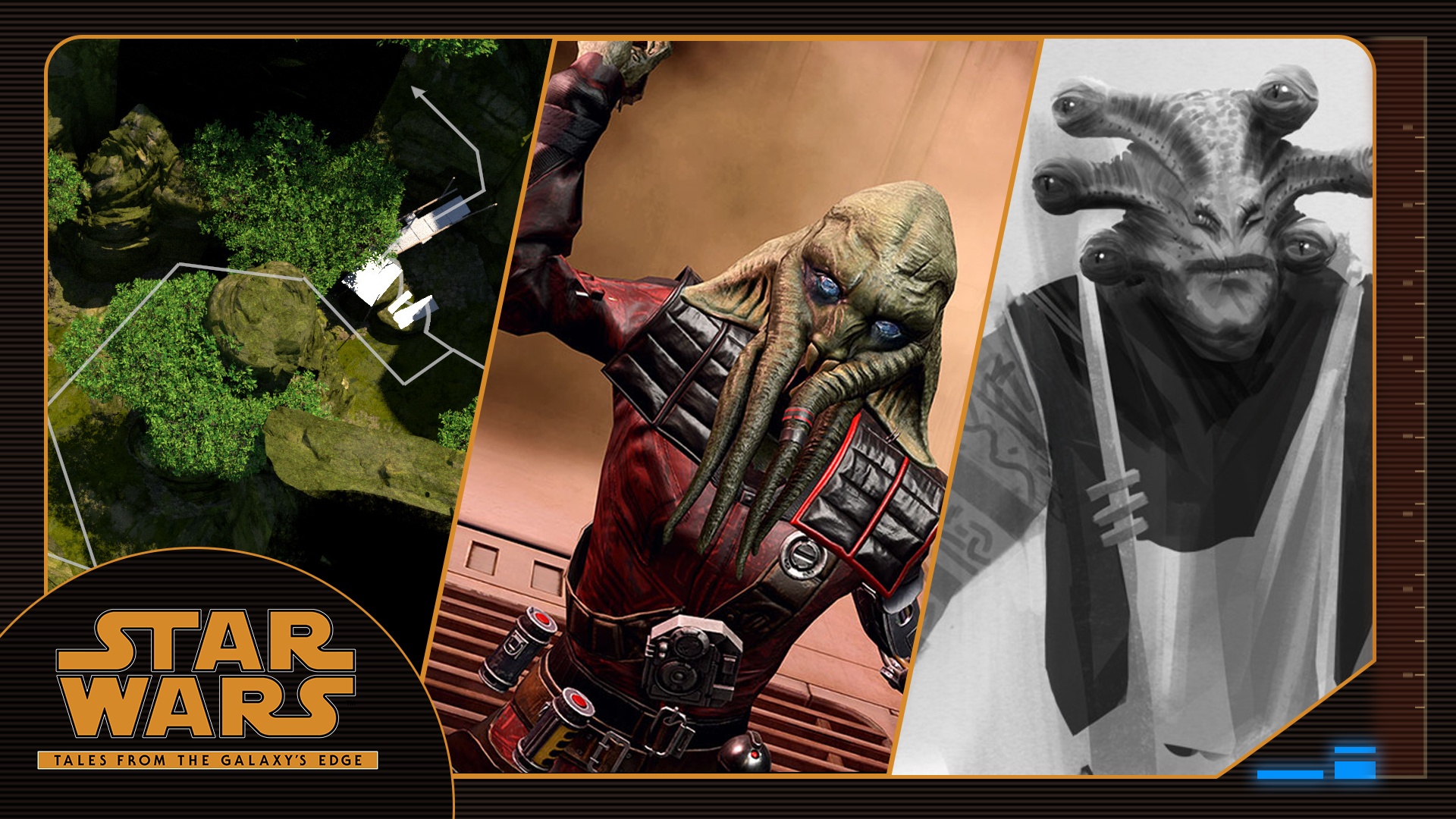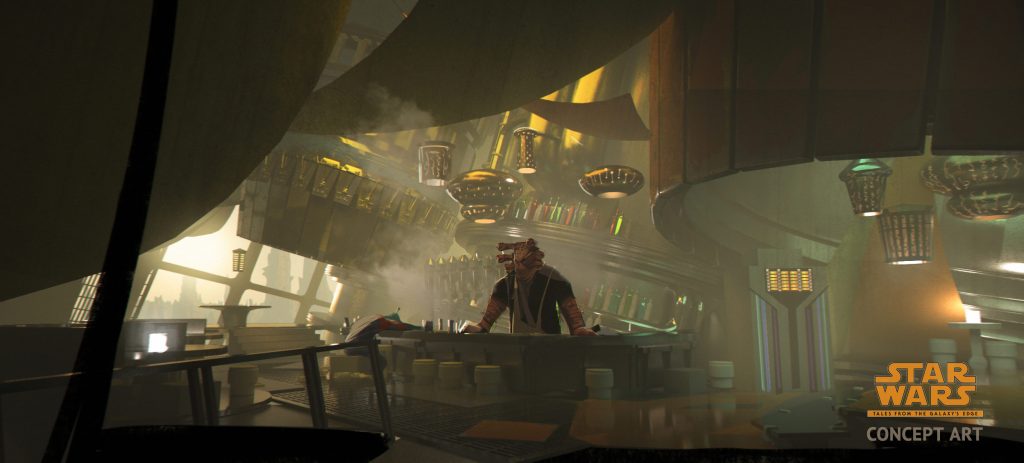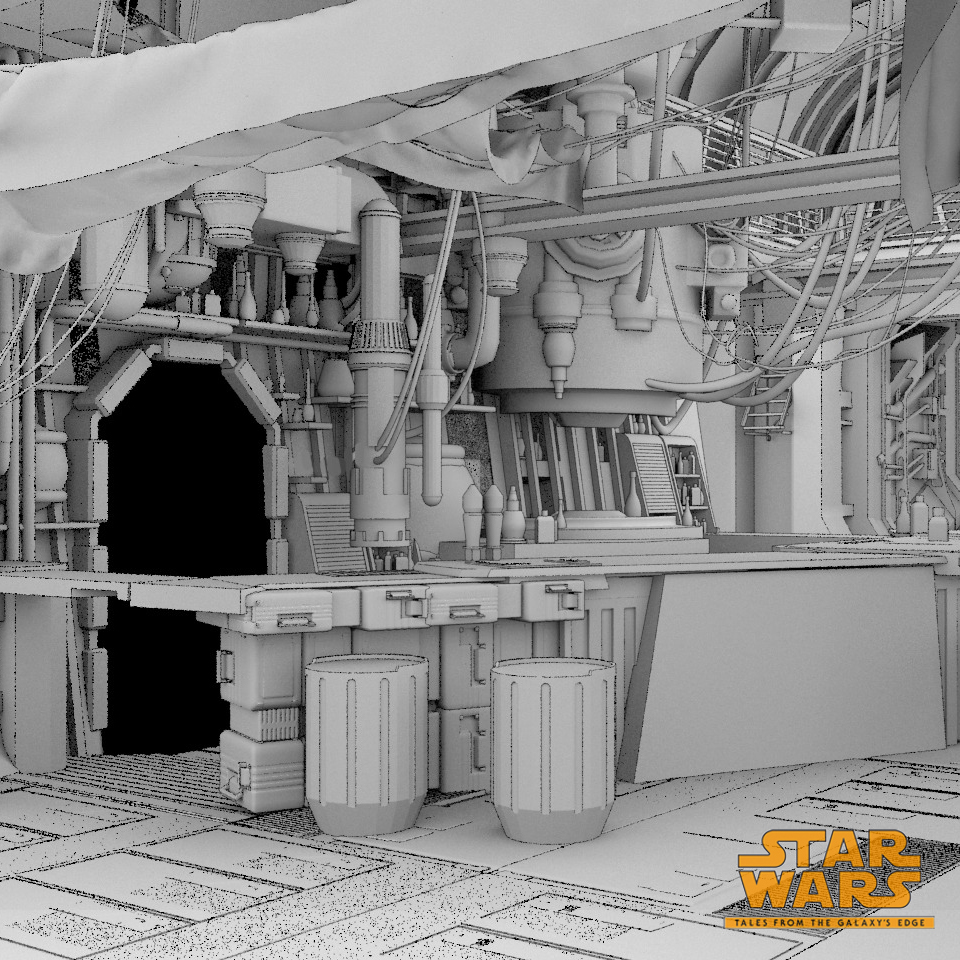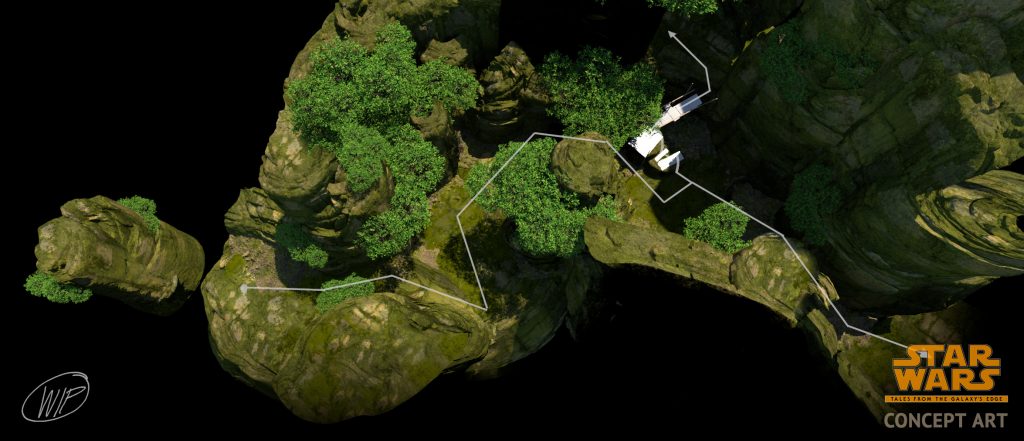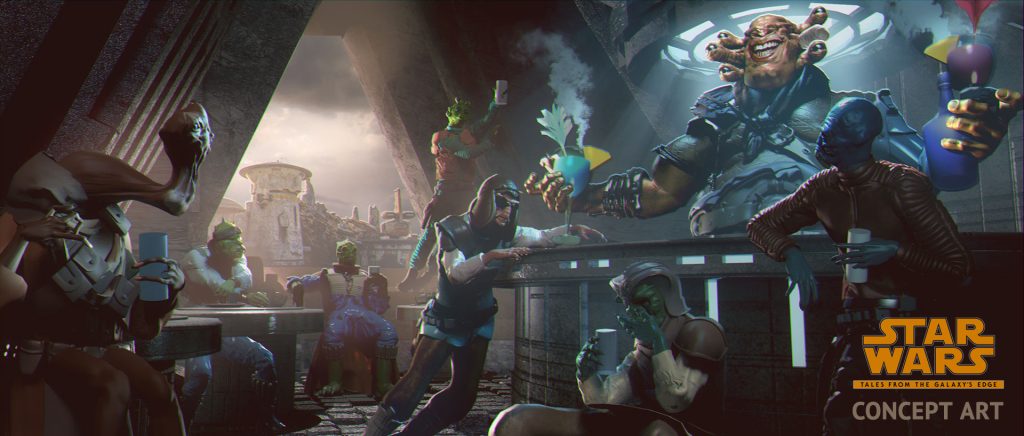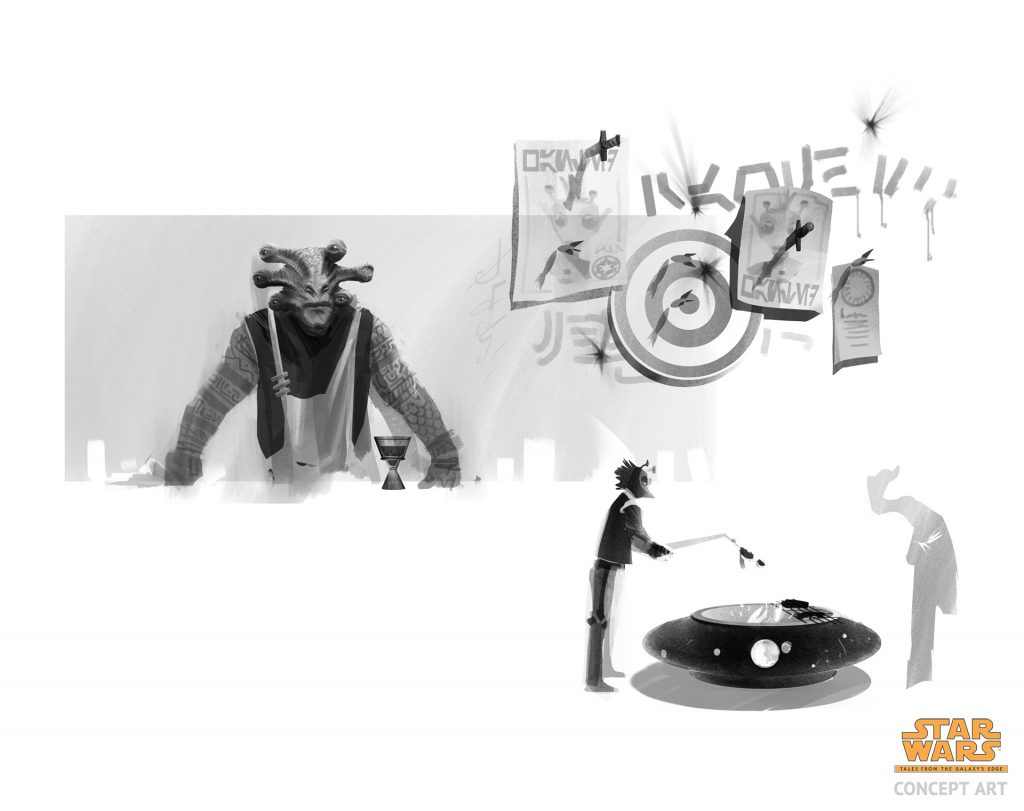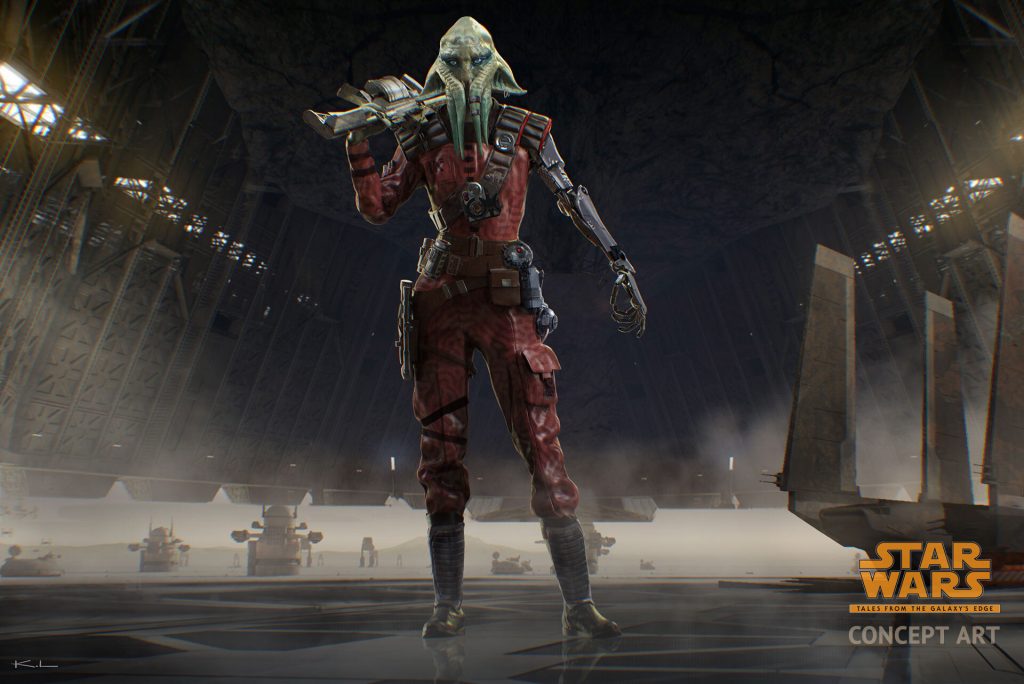The experience of playing Star Wars: Tales from the Galaxy’s Edge is as simple as slipping on an Oculus Quest headset, and opening your eyes to discover you’ve been transported into your own story on the remote planet Batuu. But creating that kind of seamless, immersive world is anything but simple, requiring the collaborative efforts of dozens of ILMxLAB animators, creative directors, engineers, story specialists, performers, and virtual reality experts.
In this three-part series, we’ll take a look at the creation of ILMxLAB’s latest project. Featuring interviews with numerous members of the creative and production team, these are the tales behind Tales.
It started with a cantina.
In 2017, director Jose Perez III had an idea to create a cantina as a means to open the door for new avenues of Star Wars storytelling in virtual reality. It would serve as a central hub for adventures, and the stories told there would transport you to other eras in the Star Wars galaxy.
When production on ILMxLAB’s award-winning Vader Immortal: A Star Wars VR Series was beginning to wrap up, Perez pitched his concept to the rest of the team at ILMxLAB. That core idea intrigued not only the immersive entertainment studio, but Lucasfilm and Oculus from Facebook as well. And with that, the team decided it was time to make the jump to lightspeed.
Landing on the Right Planet
With the cantina locale solidified, it was time to land on the greater planetary setting for the then-unnamed project. Coincidentally, the ILMxLAB team had visited Disneyland for the opening of Star Wars: Galaxy’s Edge — the immersive, epic lands located in Anaheim, California and Walt Disney World in Orlando, Florida — as this project was coming together.
“Black Spire Outpost is one of the most thoroughly thought out locations in Star Wars storytelling, from a pure worldbuilding perspective, due to the need to create a place guests can physically visit,” says Matt Martin, one of the Lucasfilm creative executives who worked tirelessly on building out the lore for Star Wars: Galaxy’s Edge.
After their visit, the team was inspired. They wanted to know even more about the planetary seeing for Galaxy’s Edge. What stories lay undiscovered on Batuu? What exists beyond the Spires? What kind of wildlife roams around the planet? And how would a Batuu resident make a living? The cantina concept, they realized, was an opportunity to answer those questions.
“Batuu gives a fun way to create brand new sections of the planet that have never been explored,” says Perez. “There are countless opportunities for storytelling,” and bringing Batuu to virtual reality could extend that worldbuilding even further. Those possibilities became even more tangible in pre-production as the initial concept art pieces sketched out the look and feel of the experience.
“This is where we start to articulate the overall vision, and craft the spirit of the game,” explains production manager Sarah Barrick. One piece of concept art in particular, she says, set the tone for what was to come. Created by concept artist Aaron McBride, the piece depicts Perez’s new Azumel cantina owner laughing, and raising handfuls of steaming and sizzling beverages in his cantina, overlooking the bustling hub of Black Spire Outpost.
“Seeing that image for the first time really captured my imagination,” says Barrick. “I heard the patrons’ hushed conversations in the corners of the bar, felt the warm breeze off the Spires, and heard the owner’s deep belly laugh.”
“It sounds cheesy, but it’s almost as if it was all coming alive on the page right there in front of me,” says Barrick. Like much of the team, that early image helped set the tone for everything that followed, with Barrick commenting that it served as her “creative North Star” every time the team approached a new challenge or milestone.
The team had found their planet. Now it was time to figure out who lived there.
Populating Batuu
Good stories only hit home if they are told by a master storyteller — someone who can bend your ear, and keep you listening. With the story’s lynchpin location and planet coming together, the idea for a colloquial cantina owner was not too far behind.
The bartender’s personality, name, and details would come later, but Perez knew that he had three attributes in mind: he wanted the character to be an alien, he wanted the character to be interesting and unique, and he wanted them to lean into the more eccentric elements of Star Wars.
“Jose had a pretty clear idea of what he wanted for that character from the start, and I don’t think it ever shifted much from that — even down to him being an Azumel,” says Martin, who was involved with Star Wars: Tales from the Galaxy’s Edge from the beginning. Along with Perez’ clear vision of the character, he eventually decided upon a name: Seezelslak.
“Seezelslak is a bit of a [Star Wars] fanboy himself, maybe a bit more aware of what’s going on in the galaxy than your average citizen,” says Martin. “We don’t really make a lot of meta jokes or break the fourth wall in Star Wars, but Seezelslak can go right up to that line which makes him really fun.”
To bring Seezelslak to life, the team turned to another Star Wars fanboy: Bobby Moynihan (Saturday Night Live, Star Wars Resistance). Moynihan had originally met members of the team at Star Wars Celebration Chicago in 2019, when he came across a demonstration of Vader Immortal: A Star Wars VR Series, and immediately wanted to play. As Tales developed, Moynihan was eager to jump onboard, utilizing his own past experience working as a bartender to inform how Seezelslak would interact with characters, or regale them with an interesting story.”
“We talked with Bobby about the character, and made up all these little backstories and quirks,” says Ross Beeley, the lead writer. “From there it was just executing that vision and giving Bobby fun stuff to play with.”
When players first meet Seezelslak, he’s angrily kicking a feathered patron out of his cantina. But Kishore Vijay, one of the animation leads on the experience, explains that Seezelslak’s “tough guy” act is just a front. Vijay would know, given how much time he spent creating the character, including creating the faux artificial intelligence behaviors that help him always feel active and alive in the experience.
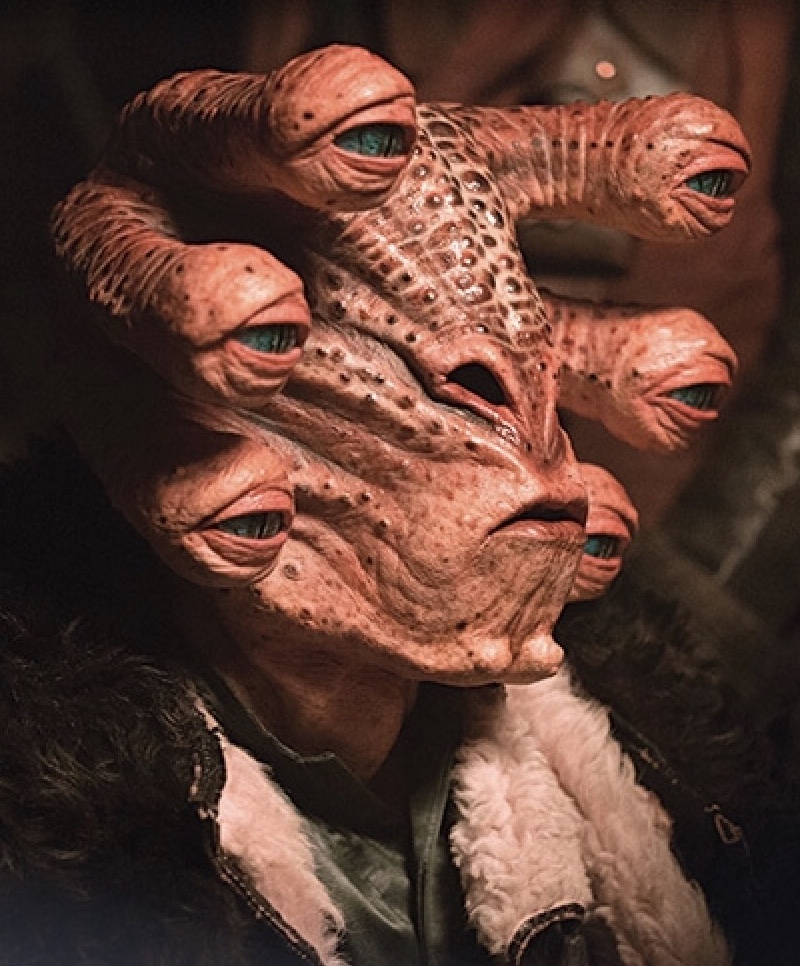
To ensure authenticity, Vijay and the animation team consumed all of the material that they could of Argus “Six Eyes” Panox — the inspiration for Seezelslak — from Solo: A Star Wars Story. They studied how the animatronic puppet’s eyestalks worked, and translated it from the film to virtual reality.
“Seezelslak turns to face us at various times during his sequences and the angle of his head depends on your location, so it was a challenge to keep his eyestalks from intersecting his shoulders and neck,” Vijay explains. But the final version of the character handled those issues with ease, always giving the player the feeling that Seezelslak was watching them.
“Not only do Seezelslak’s eye stalks work perfectly over his shoulder, but there’s a glint in his eye, too,” says producer Alyssa Finley. “Every bit takes work and there is a person behind it putting in the energy and care to ensure that this is a high-quality experience.”
Seezelslak was always going to be a bigger-than-life, colorful character. Other characters evolved over time, like Tara Rashin, the formidable leader of a Guavian Death Gang cell. With their striking red helmets, the Death Gang have become an instantly recognizable addition to the galaxy.
“You see them and you know it’s Star Wars,” says Perez. “They put you into the Sequel Trilogy era very quickly.”
“As Star Wars has taught us before, villains are best when they have grounded desires and motivations, paired with a good set of flaws and strengths,” says Beeley. “We figured out where she was on her own journey and how that would influence her actions.”
Rashin’s unique, sinister personality grew over time. Actor Debra Wilson (Star Wars Jedi: Fallen Order) contributed to the character’s evolution immediately upon joining the cast. Wilson commanded the room in every recording session, and knew that Tara Rashin would be relentless in her pursuit of whatever she wanted.
“She wanted to get to the core of the character,” says Perez. “She brought 5,000% to the role and into every recording session.” The result is a terrifying adversary that players will never forget.

